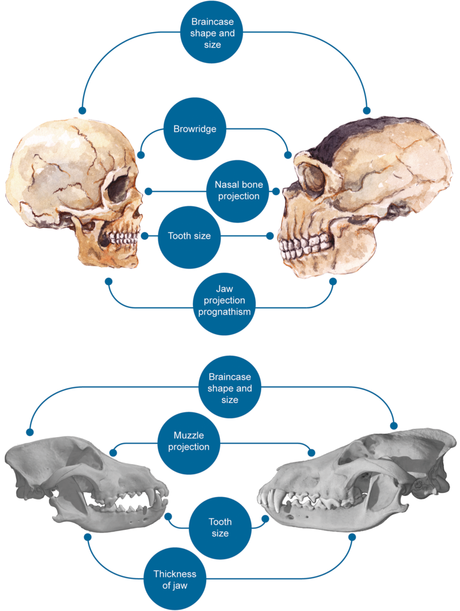Over the past few thousand years, humans have influenced the evolution of dozens of species. The biggest changes have happened in the animals we domesticated. But have humans ever been on the receiving end of this process?
It may sound like a silly question. After all, domestication is something we "do" to other species. However, in certain conditions animals can self-domesticate. They naturally evolve to fit into new niches created by humans. Have we also been self-domesticating?
Comparisons between humans and other domesticated species reveal some surprising similarities. For instance, domesticated animals often have a flatter face than their wild counterparts. This just happens to be one of the defining features of our species.
These similarities even extend into our genetics, with many genes showing similar changes in these species. As such, some have argued that the same social and environmental pressures which influenced the evolution of, for instance, dogs, may have also influenced us.
Spotting the domesticated
Over the years many different species have been domesticated, spanning the gambit from horses to guinea pigs. The sheer variety can make it hard to identify the anatomical features that define a domestic animal. Nevertheless, comparing many domestic species to their wild counterparts reveals some interesting, consistent changes in these species.
As mentioned above, many of the key changes can be seen in the skull. These include things like changes to muzzle size, tooth size, jaw thickness, and more. What makes this most interesting is that these aren't really the features people domesticating animals are looking for.
When domesticating a species, the key feature people seek out is tameness. No use having an animal that looks nice or can produce a lot of food if it will constantly try to eat you. But for some reason, breeding tame animals causes these anatomical changes.
This was demonstrated in a great Russian experiment from the height of the cold war. An undercover geneticist (as the science had been banned in 1948) was trying to domesticate foxes. Although he was breeding animals for tameness, he couldn't help but note how their anatomy changed too. In a way quite similar to domestic dogs, complete with floppy ears.
Some speculate this may be because most of these traits - both behavioural and anatomical - develop from the same line of cells, called neural crest cells. Thus, domesticators driving the evolution of one trait might alter these neural crest cells with unintended consequences.
By now you've probably seen where this is going. Many of these domestic traits are also seen in humans when compared to other members of our family, as Theofanopoulou et al. show in this excellent chart.

Domesticated genes
As nice I was about that chart, it is worth noting it's a bit cherry picked. Not every anatomical feature that separates us from other hominins lines up with this "domestication syndrome". And likewise, not every feature of that syndrome is present in us. Going back to the Russian foxes, we don't have their floppy ears.
So is the claim humans have undergone domestication based on shaky data? To explore this, researchers dived into our genetics. Like the similar anatomical features, many domestic animals have undergone similar genetic changes. Have humans also undergone these changes?
Sort of.
In humans, they found 742 genes that have been under natural selection since we split from Neanderthals and other hominin species. Of these, 41 were had also been under recent natural selection in at a domesticated species. In short, about 5% of human genes under recent natural selection could be causing self-domestication.
Now, 5% doesn't sound that impressive. But remember, domestication may be driving changes in neural crest cells. These occur early in development, and many different cells grow from them. Thus, even a small number of mutations could cause some dramatic changes. In this case, many of these genes are linked to those neural crest cells and/or (or via them) learning and cognitive development (and by extension, issues with those features, like autism).
Could being the operative word there. The impact of many of these genes has not been fully explored, so the significance of these findings is still in the air.
What happened to humans?
Many of these domesticated species were deliberately bred by humans. In other cases, a niche created by humans drove natural selection to tame them. What about humans? If we really domesticated ourselves, how did it happen?
Well - with a few rather horrific exceptions - humans haven't really been specifically bred for anything. Thus, the latter is likely what's at work. At some point in our recent evolution, we created a unique niche. Like any other niche, over time evolution ensured we became better suited to it. Although that might normally result in longer legs or stronger muscles, this niche actually drove the development of domestic features.
I speculate that, like most domestic animals, tameness really was the issue. This niche required our species to get along better, resulting in the appearance of domestic-like features. Perhaps it was our shift to living in larger, denser groups that forced us to domesticate ourselves to get along.
And if society today is what humans look like when they're "tame", I certainly wouldn't have want to meet our ancestors from before then in a dark alley.
References
Theofanopoulou, C., Gastaldon, S., O'Rourke, T., Samuels, B.D., Messner, A., Martins, P.T., Delogu, F., Alamri, S. and Boeckx, C., 2017. Self-domestication in Homo sapiens: Insights from comparative genomics. PloS one, 12(10), p.e0185306.
Wilkins, A.S., Wrangham, R.W. and Fitch, W.T., 2014. The "domestication syndrome" in mammals: a unified explanation based on neural crest cell behavior and genetics. Genetics, 197(3), pp.795-808.

